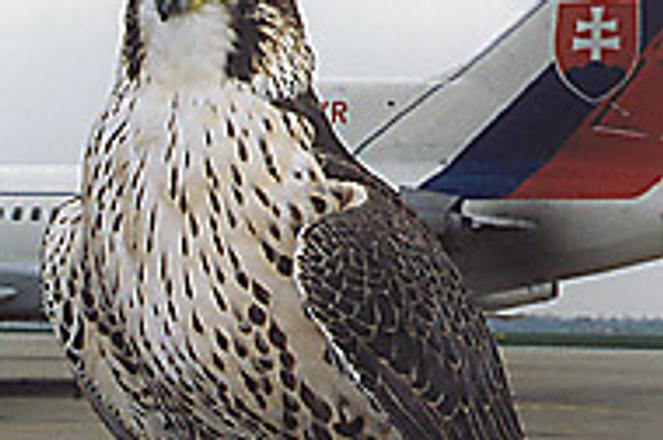Bratislava's Milan Rastislav Štefánik airport, like many around the world, uses falcons to improve safety.photo: Ján Svrček
Bratislava's Milan Rastislav Štefánik airport may have a hard time attracting passengers and major airlines, but it has no problem drawing birds.
Scores of pigeons, crows and gulls converge on the airport every day. The gathering flocks create a problem, airport officials say, as 'bird strikes' - when an aircraft hits a bird in flight - pose a serious threat to passenger safety and the aircraft themselves.
Last year, bird strikes at the Bratislava airport (which averages 22 landings and take-offs a day) damaged two planes, one of which suffered two million Slovak crowns ($42,000) in damage after a mid-air collision with a bird destroyed its engine. The problem is not limited to Slovakia: in 1960, a jet in the US struck a flock of starlings and crashed into Boston Harbour, killing 62 people, CNN reported last November. The US news channel also reported that the Israeli Air Force has in its history lost more planes to bird strikes than to enemy fire.
The two damaged Slovak planes last year signify a marked decline from the early 1980s, when up to 20 bird strikes were reported every year. The problem has been curbed, says the airport's security head Marek Ondrejovíč, through the use of falcons and hawks, birds of prey trained to scare away other potentially dangerous feathered intruders.
"When birds are spotted in the area by the control tower, security personnel or pilots, they give us a call and we drive out to the runway with the bird of prey, or sometimes dogs or shotguns, depending on the situation," explained Roman Cajkovíč, head of the airport's Biological Security Unit. "We usually use shotguns and dogs when there is an immediate danger, when birds arrive moments before a landing or a take-off. But gulls and crows tend to return soon."
The airport created the Biological Security Unit in 1985. The unit employs three staff to manage its five falcons and two hawks, as well as four hunting dogs. The unit is located far from the airport's main building amid the maze of tarmac roads and runways.
Airport bird handler Peter Plaskura keeps his falcons hungry, in order that they have incentive to hunt down runway pigeons.photo: Ján Svrček
Each of the falconers works with his own birds of prey, Ondrejovíč said, as birds form relationships with their trainers. The unit has an annual budget of just over one million crowns ($22,000), a small price to pay compared to the damage bird strikes wrought on planes last year, not to mention the threat to passenger lives.
The birds of prey have to be trained every day, says Čajkovíč, because they tend to forget their hunting routine within a week. Every morning, one of the falconers drives out to the runway area for drilling.
The birds have to be weighed before the sessions, because if they have not fully digested their previous meal, they won't chase away the wild birds. In such a condition they are not hungry, says Čajkovíč, and are therefore likely to fly away, never to return. Over the past three years, the unit has lost three birds of prey to the call of freedom. "They say that the best birds of prey usually fly away," says Čajkovíč, quoting a saying common among falconers.
The kind of bird the falcons and hawks will have to chase away depends on the weather. "Each morning we receive the weather report," Čajkovíč says. "If rain is expected, then we'll likely see gulls. If it's windy we can expect pigeons flying low above the runway."
Wild birds are generally attracted to the airport area because of its proximity to a tributary of the Danube River and the cornfields at the airport's southern edge. The nearby Slovak capital provides pigeons and crows.
Bird strikes are a problem at airports all over the world. According to the International Bird Strike Committee (IBSC), with European headquarters in Amsterdam, the first fatal bird strike accident occurred in 1912. Since 1960, "about 400 aircraft have been destroyed and 370 people killed as a result of bird and other wild-life strikes." In 1999, the US experienced over 5,000 bird strikes to its civil aircraft.
While some world airports are located in areas that do not attract many hazardous birds, more airports are adopting birds of prey as wild life deterrents. After introducing falcons and hawks in 1996, New York's JFK International had by 1999 cut the number of bird strikes by more than half, CNN reported.
At Vienna's Schwechat airport, Harold Hartmann of the Airport Operations Department said that birds of prey were not required. Instead, he said, the airport keeps the grass short to prevent birds from nesting or feeding, uses loudspeakers to project bird distress calls, fires signal guns, explodes fire-crackers and erects scarecrows.
Both Čajkovíč and Ondrejovíč said that Bratislava airport was on top of the game as far as biological security was concerned. With the runways guarded and gull-free, all they need now is more human traffic.
Author: Iulian Robu

